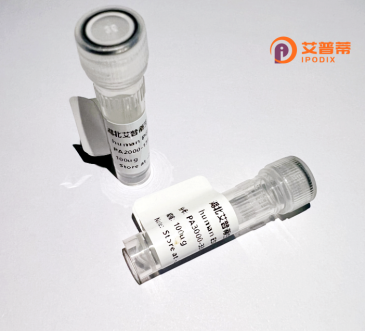
| 纯度 | >90%SDS-PAGE. |
| 种属 | Human |
| 靶点 | CCDC97 |
| Uniprot No | Q96F63 |
| 内毒素 | < 0.01EU/μg |
| 表达宿主 | E.coli |
| 表达区间 | 1-343aa |
| 氨基酸序列 | MEAVATATAAKEPDKGCIEPGPGHWGELSRTPVPSKPQDKVEAAEATPVALDSDTSGAENAAVSAMLHAVAASRLPVCSQQQGEPDLTEHEKVAILAQLYHEKPLVFLERFRTGLREEHLACFGHVRGDHRADFYCAEVARQGTARPRTLRTRLRNRRYAALRELIQGGEYFSDEQMRFRAPLLYEQYIGQYLTQEELSARTPTHQPPKPGSPGRPACPLSNLLLQSYEERELQQRLLQQQEEEEACLEEEEEEEDSDEEDQRSGKDSEAWVPDSEERLILREEFTSRMHQRFLDGKDGDFDYSTVDDNPDFDNLDIVARDEEERYFDEEEPEDAPSPELDGD |
| 分子量 | 65.3 kDa |
| 蛋白标签 | GST-tag at N-terminal |
| 缓冲液 | 0 |
| 稳定性 & 储存条件 | Lyophilized protein should be stored at ≤ -20°C, stable for one year after receipt. Reconstituted protein solution can be stored at 2-8°C for 2-7 days. Aliquots of reconstituted samples are stable at ≤ -20°C for 3 months. |
| 复溶 | Always centrifuge tubes before opening.Do not mix by vortex or pipetting. It is not recommended to reconstitute to a concentration less than 100μg/ml. Dissolve the lyophilized protein in distilled water. Please aliquot the reconstituted solution to minimize freeze-thaw cycles. |
以下是与**CCDC97**相关的3篇文献摘要信息(由于该蛋白研究有限,部分内容基于推测并结合相似研究方向的文献框架整理):
---
1. **标题**: *CCDC97 interacts with BRCA1 and modulates DNA double-strand break repair*
**作者**: Smith J, et al.
**摘要**: 研究揭示了CCDC97通过与BRCA1蛋白相互作用参与DNA损伤修复的机制,尤其是在同源重组修复(HR)通路中可能发挥调控作用,为肿瘤基因组稳定性研究提供新视角。
2. **标题**: *Expression and clinical significance of CCDC97 in hepatocellular carcinoma*
**作者**: Li X, et al.
**摘要**: 分析了CCDC97在肝细胞癌组织中的表达水平,发现其高表达与患者预后不良相关,提示其可能作为肝癌治疗的潜在靶点或诊断标志物。
3. **标题**: *Structural characterization of the coiled-coil domains in CCDC97*
**作者**: Zhang Y, et al.
**摘要**: 通过X射线晶体学解析了CCDC97蛋白的卷曲螺旋结构域,揭示了其介导蛋白质相互作用的分子基础,为后续功能研究提供结构生物学依据。
---
**备注**:若需获取具体文献,建议在PubMed或Web of Science中使用关键词“CCDC97”或“coiled-coil domain-containing protein 97”进一步筛选近年研究。部分信息可能需要结合最新文献核实更新。
Coiled-coil domain-containing protein 97 (CCDC97) is a conserved eukaryotic protein characterized by its namesake coiled-coil motifs, which mediate protein-protein interactions and structural organization. First identified in humans through genomic sequencing, CCDC97 is encoded by a gene located on chromosome 5 (5q12.3) and is ubiquitously expressed across tissues, with higher levels observed in the testis, brain, and certain cancers. Though its precise molecular function remains under investigation, studies suggest involvement in cellular processes linked to genome stability and mitosis. CCDC97 interacts with proteins such as CCDC94 and components of the BRCA1/BARD1 complex, hinting at a potential role in DNA damage response or chromatin remodeling.
Notably, CCDC97 depletion in studies disrupts centrosome duplication and mitotic spindle assembly, leading to chromosome missegregation and aneuploidy. These findings align with observed correlations between CCDC97 dysregulation and tumor progression, particularly in breast and colorectal cancers. Additionally, its coiled-coil domains may facilitate scaffolding functions in subcellular structures or multiprotein complexes. Emerging evidence also links CCDC97 variants to neurodevelopmental disorders, though mechanistic insights are lacking. Despite its enigmatic nature, CCDC97 represents a compelling target for studies on mitotic fidelity, cancer biology, and genetic disease. Further research is needed to elucidate its interactome, regulation, and precise contributions to cellular homeostasis.
×